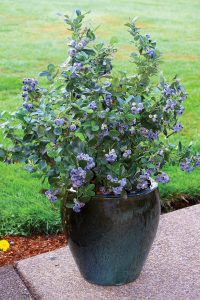I grew up canoeing in the wilds of Maine and Quebec every summer, and developed an early addiction to wild blueberries. We would paddle from island to island where high-bush berries hung heavy from rock outcroppings in the cold massive lakes. I swear they were bigger than I’ve seen since, and I still dream of effortlessly running my hand through the leaves and coming out with a handful of plump berries.

When I started to farm, growing blueberries was a natural choice. The UCSC Farm and Garden where I trained has an amazing blueberry stand, where over the years they’ve learned just what needs to be done to be successful. I took this knowledge with me to Petaluma Bounty where we were gifted about 100, 7-year old blueberry bushes to plant. What an amazing addition to the farm! I highly recommend you plant a blueberry bush are two. Here are some growing tips I’ve amassed over the years.
Select a Couple of Varieties
Blueberries are self-pollinating which means that you only need one bush to get fruit. However, the fruit will be much more prolific if you plant two or more varieties. Here’s a couple of popular varieties to consider:
Jubilee – Sweet fruit. Great for eating fresh. Performs well in heavier soils through summer heat and winter cold. Upright growth to 6 feet.
Misty – Sweet, spicy fruit. Upright spreading growth to 4-6 feet. Attractive and high yielding. Great landscape plant.
O’Neal – This one is considered to have the best flavor. Juicy, sweet fruit. Upright spreading growth to 4-6 feet. Great fresh eating.
Sharpblue – Delicate and sweet fruit. Upright spreading growth to 4-6 feet. This one is the most adaptable variety in low-chill areas. Good landscape plant.
Sunshine Blue – Semi-dwarf, evergreen blueberry. Features eye-catching hot-pink flowers that fade to white in the spring. Yields large crops of rich, sweet berries. Tolerates higher pH soils than many other blueberries. Ideal for containers.

Think About pH
Blueberries need acidic soil in order to thrive – somewhere between 4.5 and 5.5 is ideal. I’ve talked before about the importance of getting your soil tested, and learning your pH is one important piece of information you’ll gain. Most of us have soil more basic than this narrow range, so when in doubt you can assume that you will in fact need to amend your soil to be more acidic.
While you can’t completely alter the pH of your soil, there are a few things you can do. First of all, you can mix some acidic elements deep into your planting hole. Either pre-moistened peat moss or wood chips work well, as does Tiger Sulfur.
Then, when your blueberries get established, you can add apple cider vinegar to your irrigation water – about 1 tablespoon per gallon. This can be easily mixed in a watering can, or injected through a fertilizer if you have a drip irrigation system and are feeling fancy.
Plant Timely
Highbush blueberry varieties should be planted in early to mid-fall for best results. December and January are also good months to place new blueberry plants in the ground because of winter dormancy.
Irrigate Wisely
Blueberries have shallow roots that don’t like to sit in water. This has a few implications. First of all, when you choose your planting site, make sure there is superb drainage. If your soil is especially heavy clay or really under any conditions, it will help to build a raised bed or a berm for your plants, this way water can drain out through the pathway.
Mulch, Mulch, Mulch
Mulch your plants heavily (2-4 inches) with wood chips, which will not only help to acidify the soil but will hold in moisture. Mulch will also prevent weeds and add organic matter. And then make sure to water regularly. Those shallow roots can’t go more than a few days in our dry Sonoma County summers without a heavy watering.
Keep The Birds Off!
I’ve heard a lot of sad stories about birds eating berries that we’re yet ripe. A word to the wise: net your plants early! As soon as you have the area set up, weeded and mulched, go ahead and throw up a netting system. It doesn’t hurt to do it too early – and we all know the consequences of waiting too late.
So go get some blueberries in the ground! Fall is a great time to plant. Talk to your local garden center about what varieties would work well for you, and go dig some holes.







 Family
Family

